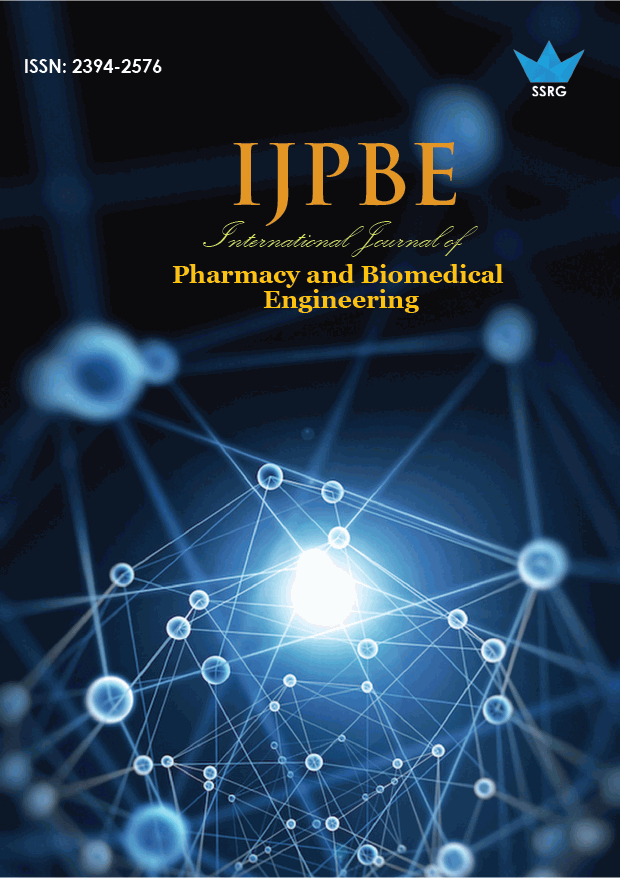Microencapsulation: Applications in the Different Dairy Products

| International Journal of Pharmacy and Biomedical Engineering |
| © 2019 by SSRG - IJPBE Journal |
| Volume 6 Issue 3 |
| Year of Publication : 2019 |
| Authors : Suchita Bhosale, R.J.Desale, Y.G.Fulpagare |
How to Cite?
Suchita Bhosale, R.J.Desale, Y.G.Fulpagare, "Microencapsulation: Applications in the Different Dairy Products," SSRG International Journal of Pharmacy and Biomedical Engineering, vol. 6, no. 3, pp. 7-11, 2019. Crossref, https://doi.org/10.14445/23942576/IJPBE-V6I3P102
Abstract:
Dairy and food industries are in a major technological and sociological revolution. There is no better example than dramatic changes occur in the availability of various products and consumer choice. There are various types of encapsulation technologies that can be employed in the food industry. The use of different encapsulation technologies for the protection of health ingredients achieved high ingredient efficiency. Microencapsulation is defined as a technology of packing solids, liquids, or gaseous materials in miniature, sealed capsules that can release their contents at controlled rates under specific conditions. The advantages of microencapsulation and nanotechnology have opened up new opportunities that can revolutionize dairy products processing. The present paper reviews the emerging trend and some of the potential applications of encapsulation technique in the field of agriculture with a precise exceptional pivot towards dairy science research interventions.
Keywords:
Nanotechnology, Microencapsulation, Nutraceuticals, Bioavailability, Viability
References:
[1] Choi, H.J., J. Ahn, N.C.Kim and H.S.Kwak,2006.”The effects of microencapsulated Chito oligosaccharide on the physical and sensory properties of the milk”. Asian Australasian J.of Animal Sci.19:1347-1357.
[2] Jalil Maryam, 2016. “Chemical Composition and sensory characteristics of feta cheese fortified with iron and ascorbic acid”. Diiry Sci. & Technol., 96:579-589.
[3] Jeon, B.J., N.C.Kim, E.M.Han, and H.S.Kwak.,2005. “Application of microencapsulated isoflavone into milk”. Archives of Pharmacology Research,7:859-865.
[4] Jimenze, M., H.S.Garcia, and C.I.Beristai,2006. “Spraydried encapsulation of Conjugated linoleic acid (CLA) with polymeric matrices”.J. Of the Sci.of Food and Agriculture, 86 2431-2436.
[5] Karthikeyan N., A.elango, G.Kumaresan, T.R.gopalarikrishnamurty and B.V.Raghunath, 2014. “Enhancement of Probiotic viability in ice cream by microencapsulation”. International J.Of Sci.,Environment ,3:(1),339-347.
[6] Kwak Hae-Soo, Mohammad Al Mijan, and Palanivel Ganesan,2014. “Application of Nanomaterials, nano, and Microencapsulation to milk and dairy products”. Nano and Microencapsulation for Food,1:273-300.
[7] Mandal, Surajit, 2013. Microencapsulation: a delivery system for functional food ingredients.28th National training, CAFT, Dairy processing, Dairy Microbiology Division, NDRI, Karnal.
[8] Mozafari Reza M., Kianoush Khosravi Darani, G.Gokce Borazan, Jian Cui, Abbas Pardakhty, and Seyhun Yurdugul, 2008.Encapsulation of food ingredients using nanoliposomes technology.International J. of Food Properties,11:833-844.
[9] R.Subhash, A. Elango, C.Pandiyan, N. Karthikeyan, and G.Kumaresan, 2015. “Fortification of microencapsulated iron in yogurt”. International J. Of Food and Nutritional Sci.,4(1),201-205.
[10] Thangaraj S and M.Seethalakshmi, 2015. “Application of microencapsulation technology for the production of vitamin –C fortified flavored milk”. J.Advances in dairy Res., 3 :( 3).
[11] Özge İnşaatçı, Necla Yaman Turan, (2018). “Encapsulation of Propolis by Complex Coaservation Technique: Preparation and Characterizations”. SSRG International Journal of Polymer and Textile Engineering 5(3), 15-20.

 10.14445/23942576/IJPBE-V6I3P102
10.14445/23942576/IJPBE-V6I3P102